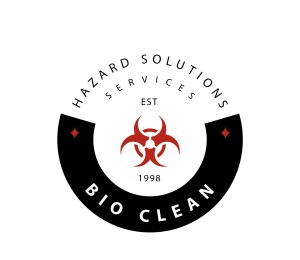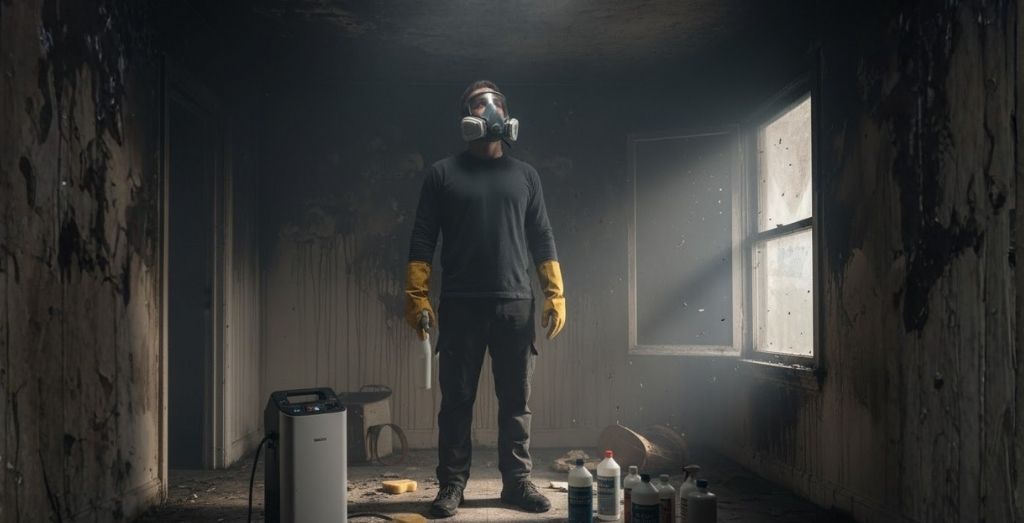Walk into a home where hoarding has taken over, and you’ll see what looks like years of life compressed into impossible piles. Mountains of newspapers. Towers of cardboard boxes threatening to topple. Narrow pathways carved through belongings that haven’t been touched in who knows how long.
But here’s what most people don’t realize—all that stuff isn’t just cluttered. It’s downright dangerous.
Cleaning a hoarded property isn’t like hauling away junk from your garage. It’s a serious biohazard situation that demands real training, serious patience, and gear that can actually keep you safe. Without proper protective equipment for hoarding cleanup, you’re gambling with your health every time you reach for another box or bag.
The truth is, when you’re cleaning hoarded homes safely, one careless move can put you face-to-face with toxic mold, disease-carrying bacteria, needles hidden in piles, or chemicals that have been sitting there leaking for years. Hoarding cleanup safety in Everett, Seattle, WA, and the surrounding WA locations isn’t about making things look nice again—it’s about making sure nobody gets hurt or sick while getting the job done.
The Real Risks Involved in Hoarding Cleanup
Most folks have no idea just how hazardous these spaces become after months or years of accumulation.
Let’s walk you through the actual hoarding health risks that professionals deal with every single day:
Hazard Type | Description | Potential Risks |
| Biological Hazards | Rotting food, animal droppings, human waste | Bacterial infections, viral diseases, parasitic exposure |
| Airborne Contaminants | Layers of dust, toxic mold spores, decomposed particles | Lung infections, severe allergies, respiratory diseases |
| Structural Hazards | Floors ready to give way, unstable piles, hidden sharp objects | Serious cuts, broken bones, falling injuries |
| Chemical Hazards | Old cleaning supplies, expired pills, leftover fuel | Poisonous fumes, chemical burns on skin |
| Pest Infestations | Rats, mice, roaches drawn to the mess | Disease spread, bites, worsening contamination |
According to the leading hoarding cleanup service experts in Seattle, WA, this is exactly why biohazard cleanup safety protocols exist. Professional hoarding cleanup service crews approach hoarded spaces with the same level of caution they’d use at a crime scene or drug lab—because the risks are honestly that severe.
Essential Protective Gear for Hoarding Cleanup
Before anyone moves even one bag of trash, the right equipment needs to be on. This isn’t about being comfortable—it’s about staying alive and healthy. Here’s what makes up a proper hoarding cleanup safety kit:
1. Respiratory Protection
The air in hoarded homes? It’s loaded with stuff you absolutely don’t want in your lungs. Mold floating around invisibly. Dried waste turned to dust. Materials breaking down and releasing particles you can’t even see.
Professionals count on:
- N95 or P100 respirators that actually filter out microscopic threats.
- Full-face respirators are used when dealing with really bad contamination or unknown substances.
Leading hoarding cleanup service experts in Everett, WA, this respiratory protection for cleanup lets workers breathe without constantly worrying about what they’re inhaling—even when conditions get truly awful.
2. Gloves: Your First Line of Defense
Your hands do practically everything during cleanup, which means they’re also taking the biggest beating. Broken glass buried in piles. Rusted nails sticking out. Items covered in who-knows-what.
- Nitrile or cut-resistant gloves stop punctures and keep biohazards off your skin.
- Double-gloving (disposable underneath, heavy-duty on top) maintains hygiene when switching between tasks.
The right gloves and masks for hoarding cleanup stop infections and injuries that might not show up until days later—when it’s too late to do much about them.
3. Protective Clothing
From the top of your head to the bottom of your boots, nothing gets left exposed. Hoarding cleanup protective clothing includes:
- Disposable coveralls that prevent the spread of contamination everywhere.
- Steel-toed boots protect against sharp debris and heavy objects that may drop.
- Disposable shoe covers stop cross-contamination as you move from room to room.
According to the leading hoarding cleanup service contractors in Seattle, WA, clothing gets changed after every shift or cleanup stage—because once a suit picks up contamination, it basically becomes a walking hazard.
4. Eye and Face Protection
Dust clouds. Mystery liquids dripping from collapsing piles. Debris flying when something shifts unexpectedly.
Professionals wear:
- Safety goggles or full face shields block liquid splashes and airborne particles.
- Anti-fog lenses so you can actually see what you’re doing in stuffy, humid spaces.
This focus on eye safety forms a cornerstone of safe hoarding cleanup practices—and it’s something untrained people almost always skip.
5. Other Safety Equipment
Sometimes the gear that seems least important ends up being what saves you.
Additional essentials include:
- Hard hats for rooms where ceilings sag or piles could collapse.
- Bright flashlights or headlamps, because half these spaces have terrible lighting.
- Knee pads and back braces to reduce strain from hours of physical work.
- First-aid kits are right there for immediate treatment if something goes wrong.
According to leading hoarding cleanup service contractors in Everett, WA, being prepared transforms chaos into something manageable —an absolute essential in professional hoarding cleanup procedures.
Safe and Systematic Hoarding Cleanup Procedures
Having the right equipment only gets you so far. Cleaning a hoarded property demands precision and careful planning. Professional cleanup follows specific safe hoarding practices designed to minimize danger while actually getting the job done.
1. Initial Assessment
Every job begins with walking through the entire property (yes, in full protective gear) to spot hazards, identify contaminated zones, and figure out what’s even accessible. According to the leading hoarding cleanup service specialists in Seattle, WA, this assessment determines timeline, team size, and which safety measures need priority attention.
2. Establishing a Cleanup Plan
Once the assessment wraps up, professionals build a detailed roadmap covering:
- Separating areas by contamination severity.
- Identifying salvageable items versus disposal candidates.
- Assigning specific roles and safety responsibilities to each team member.
This structured approach prevents confusion and unnecessary exposure—a critical element of all hoarding cleanup procedures.
3. Ventilation and Air Quality Control
Getting fresh air moving isn’t just nice—it’s protection. Before active cleaning starts, windows are opened and HEPA filtration systems are set up to pull airborne contaminants out. This controls mold spores, dust clouds, and overwhelming odors while improving safety and mental clarity for everyone working.
4. Proper Waste Disposal
Items from hoarded homes aren’t regular trash—they’re often legitimate biohazard waste. Leading hoarding cleanup service experts in Everett, WA, reveal that contaminated furniture, spoiled food, and soiled clothing—all require proper disposal in accordance with strict regulations.
Professionals make sure:
- Waste gets bagged and labeled correctly for transport.
- All disposal follows state-approved biohazard laws.
- Clean zones stay completely separate from contaminated ones.
Safe and ethical waste disposal prevents public exposure and keeps environmental contamination from spreading.
5. Disinfection and Sanitization
After all the debris clears out, the real work begins. Using industrial-strength cleaners, safe disinfection after hoarding targets the elimination of bacteria, viruses, and stubborn odors that have soaked into surfaces.
Disinfection typically involves:
- EPA-registered antimicrobial agents
- Steam or heat treatments for certain materials
- Fogging systems reach into hidden cracks and crevices
This process transforms the property from a hazardous environment back into an actual livable space.
6. Final Safety Checks
Before anyone moves back in, professionals conduct thorough final inspections verifying:
- Zero contaminated materials remain anywhere
- Air quality has returned to safe levels
- Every surface has been properly disinfected
Only after passing these rigorous safety checks does the property get cleared—and residents can finally begin reclaiming their space with genuine peace of mind.
Why Relying on Professionals Is the Smart—and Safe—Choice
Hoarding cleanup seems like something determination and hard work could handle. But underneath all that clutter sits a complex, unpredictable world of biohazard cleanup safety concerns. That’s exactly why professional hoarding cleanup services aren’t just helpful—they’re absolutely necessary.
Experts bring:
- Years of specialized training in handling dangerous biohazards.
- Access to industrial-grade disinfectants and equipment.
- Deep knowledge of federal and state safety regulations.
- Emotional awareness is essential when working in incredibly distressing situations.
Bio Clean Inc., a trusted leader in hoarding cleanup in Everett and Seattle, WA, has built its reputation through years of compassionate, compliant work throughout Washington State. Our certified team approaches every cleanup—hoarding, crime scenes, mold remediation—with professionalism, genuine empathy, and complete discretion.
We serve communities across the region, helping families return to safe, livable homes without reliving trauma or facing health hazards.
Final Takeaway: Restoring Safety, Dignity, and Peace of Mind
Hoarding cleanup goes way beyond just hauling away debris—it’s about restoring safety, dignity, and some sense of normalcy to people’s lives. With layers of serious risk hiding behind every single item, only trained professionals can guarantee the process gets handled with proper care, extreme caution, and real respect.
For families throughout Washington, from Bellevue to Renton, Everett, and Bellingham, Bio Clean Inc. represents the compassion and safety you can actually count on. Whether it’s hoarding cleanup, crime scene remediation, drug house decontamination, or mold removal, our certified team responds with urgency and genuine empathy, making sure each environment isn’t just cleaned but made truly safe again.
If you or someone you know needs professional hoarding cleanup services in Seattle, Everett, WA, or the neighboring locations, reach out to Bio Clean Inc. today at (888) 412-6300. Our 24/7 response team stands ready to help you take that first crucial step toward reclaiming your home and your peace of mind.







